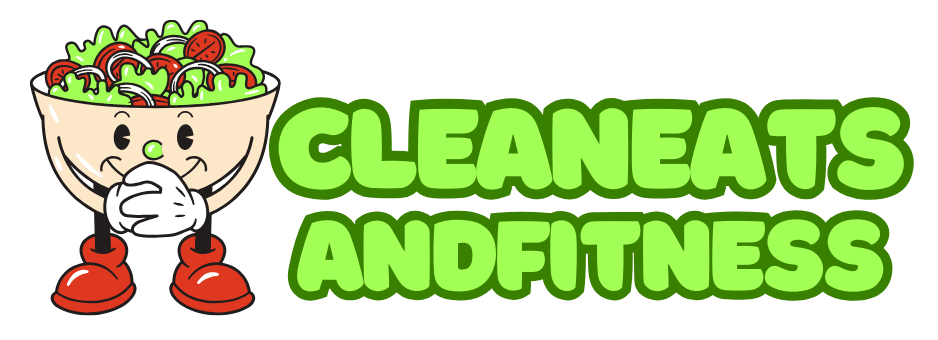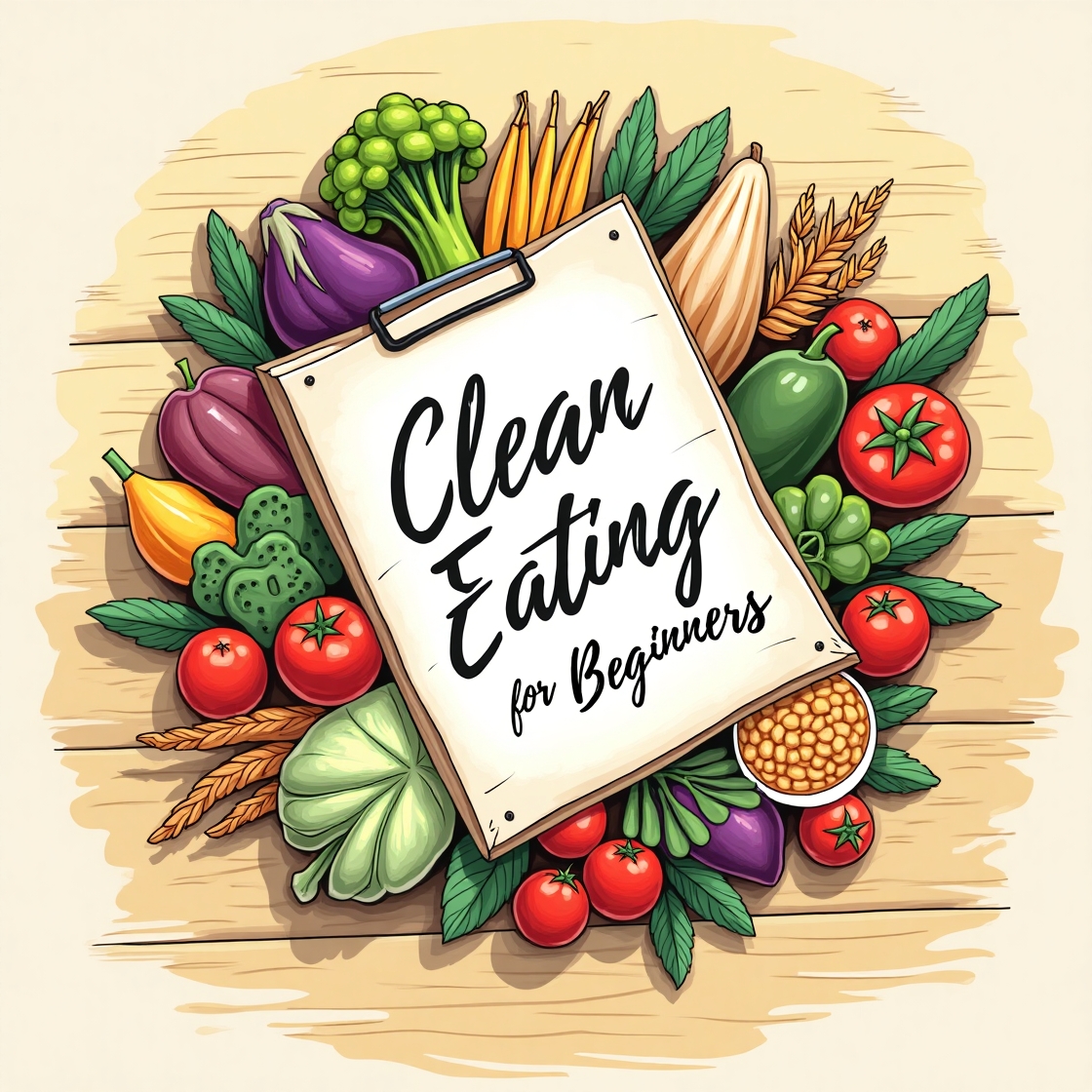Clean Eating Grocery List: Your Guide to Healthy Shopping
Ever wondered why diets often fail while clean eating succeeds? It’s all about choosing whole foods. This guide shows you how a clean eating grocery list can change how you shop. It boosts your health too. We’ll cover clean eating basics, its benefits, and how to start. With these tips, you’ll shop smarter and hit your health goals.
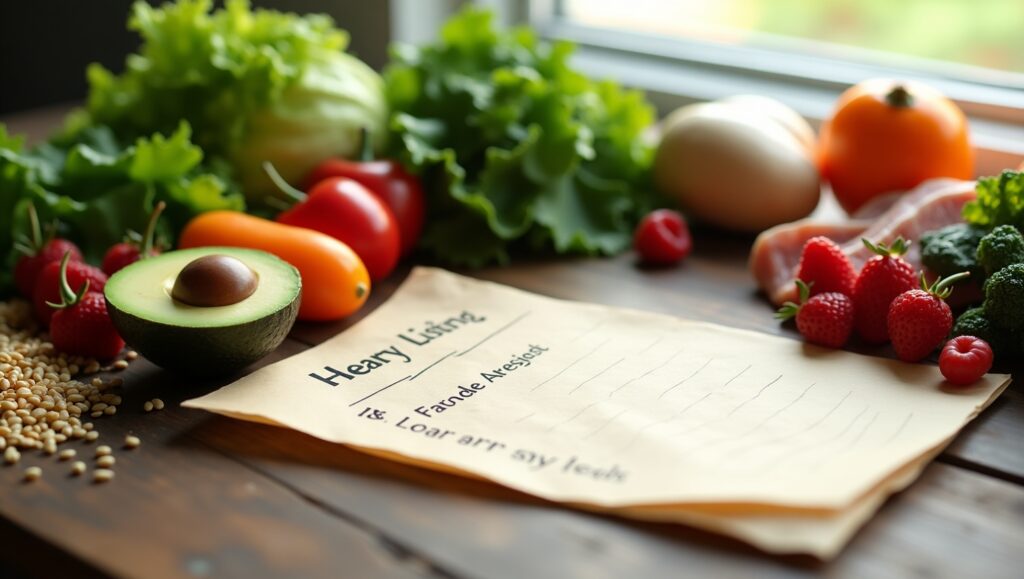
A neatly organized and visually appealing grocery list against a clean, minimalist background. In the foreground, various healthy and organic food items are meticulously arranged, including fresh produce, whole grains, lean proteins, and dairy products. The lighting is soft and natural, accentuating the vibrant colors and textures of the items. The camera angle is slightly elevated, providing a bird’s-eye view that conveys a sense of order and simplicity. The overall mood is one of freshness, wholesomeness, and the joy of clean eating and healthy living.
Key Takeaways
- Clean eating emphasizes whole foods and minimal processing.
- A clean eating grocery list helps guide healthy choices while shopping.
- Understanding clean eating can enhance your nutrition and overall health.
- Practical tips in this guide will make clean eating approachable for beginners.
- Incorporating a variety of foods is essential for balanced nutrition.
Understanding Clean Eating
Clean eating means loving whole, natural foods that make you healthy. It’s about choosing foods without bad additives or too much sugar. By doing this, you take good care of your health and make smart food choices.
Eating clean is all about fresh fruits, veggies, lean meats, nuts, and grains. These give you important nutrients for your health. Learning about clean eating can change how you see your meals. It lets you try many healthy foods.
Following clean eating helps you have a better bond with food. It’s good for your body and improves your life. Picking the right foods when you shop helps you meet your health goals.
Benefits of Clean Eating
Clean eating is great for your health and can make your life better. It focuses on whole foods that are full of important nutrients. This way of eating helps you control your weight, which is a goal for many.
Eating clean also means better digestion. Foods like whole grains, fruits, and veggies are rich in fiber. This improves your gut health and digestion, making you feel more comfortable.
Another plus is more energy. Clean foods give you energy that lasts, unlike junk food that makes you crash. You’ll feel more awake and ready to do your daily tasks.
Studies show eating lots of whole foods improves your mood and how well your brain works. Eating better can make you happier and think clearer. Cutting down on sugar and fake additives is key for this.
| Health Benefits | Details |
|---|---|
| Weight Management | Balanced diet helps in maintaining a healthy weight. |
| Better Digestion | Increased fiber intake promotes gut health. |
| Increased Energy Levels | Natural foods ensure a steady energy release. |
| Enhanced Mood & Cognitive Function | Whole foods contribute to better mental clarity. |
What is a Clean Eating Grocery List?
A clean eating grocery list helps you choose foods that are good for you. It focuses on fresh, whole items and cuts down on processed foods. This list helps you make healthier choices when shopping.
When you make a clean eating grocery list, you look at important food types. It usually has:
- Fruits
- Vegetables
- Whole grains
- Lean proteins
- Healthy fats
This method makes sure your shopping is balanced and good for you. A smart list stops you from buying things on a whim. It makes sticking to your healthy eating plan easier. By choosing these food groups, you’re ready to make the best meals.
Here’s a look at the food groups:
| Category | Examples |
|---|---|
| Fruits | Apples, Bananas, Berries |
| Vegetables | Spinach, Broccoli, Carrots |
| Whole Grains | Brown Rice, Quinoa, Oats |
| Lean Proteins | Chicken Breast, Tofu, Lentils |
| Healthy Fats | Avocados, Nuts, Olive Oil |
Using your clean eating list well sets up a healthy way of life. Grocery trips become more focused. This leads to better food choices for meals and a happier, healthier you.
Key Principles of Clean Eating
Learning about principles of clean eating is key for a better lifestyle. Start by eating less processed foods. These foods have stuff that’s not great for you. Try eating whole, fresh foods instead. These include fresh fruits, veggies, whole grains, and lean meats.
Try to pick organic foods if you can. They have less pesticides and more nutrients. Knowing about seasonal fruits and veggies makes your meals tastier and healthier.
How you make your food is also important. Use methods like steaming, grilling, and baking to keep the goodness in your food. Cooking at home saves time. It keeps you true to your clean eating goals.
Using these tips every day can really help. You’ll learn a lot about principles of clean eating. This lets you make better food choices. Choices that help you meet your health goals.
Clean Eating for Beginners: Getting Started
Starting your clean eating journey is both exciting and life-changing. If you’re new, learning about whole foods and how to plan your shopping list is key. This part offers easy tips to guide beginners through clean eating.
Identifying Whole Foods
Whole foods are those not heavily processed, keeping their natural goodness. When you shop, pick fresh fruits and veggies, whole grains, lean meats, and healthy fats. Include options like:
- Organic fruits like apples, bananas, and berries
- Vegetables such as leafy greens, carrots, and bell peppers
- Whole grains like quinoa, brown rice, and oats
- Lean proteins, including chicken, fish, beans, and legumes
Choosing well at the store is the first step toward meeting your clean eating goals.
Organizing Your Shopping List
Having a well-planned shopping list makes grocery shopping simpler and keeps you true to clean eating. Group items by type to find them quickly in the store. Your list could look like this:
| Category | Items |
|---|---|
| Fruits | Apples, Bananas, Berries |
| Vegetables | Spinach, Carrots, Broccoli |
| Grains | Quinoa, Brown Rice, Oats |
| Proteins | Chicken, Fish, Lentils |
| Healthy Fats | Avocado, Nuts, Olive Oil |
By doing this, you make sure you get everything needed for clean eating. With some prep and learning, starting clean eating becomes simpler and fun.
Creating a Healthy Grocery List
Starting your healthy grocery list with fresh produce and whole grains is key. These foods give you important nutrients and keep your diet balanced. Choosing fruits and veggies that are in season can make your meals taste better and be healthier.
Selecting Fresh Produce
Choose fruits and veggies that are local and in season for the freshest options. This helps local farmers and makes sure you get the best taste and nutrition. Here’s how to pick the freshest produce:
- Look for bright colors; they usually mean the produce is ripe and full of nutrients.
- Think about going to farmers’ markets for fresh, seasonal finds.
- Feel for firmness and skip any with soft spots or blemishes.
Choosing Whole Grains
Whole grains are a big part of a healthy shopping list. They keep all their good-for-you parts, unlike refined grains. This gives you more fiber, vitamins, and minerals. Here are some tips for adding whole grains to your list:
- Choose brown rice, quinoa, or whole wheat pasta instead of white versions.
- Try different types like farro, barley, or bulgur to mix things up.
- Make sure “whole grain” is the first thing on the ingredient list.
Your Clean Eating Grocery List
Making a clean eating grocery list helps you pick healthier foods. It guides you to choose foods full of nutrients that meet your health goals. You’ll add many fruits and veggies, plant proteins, lean meats, and healthy fats to your diet.
Fruits and Vegetables to Include
Add fresh, seasonal produce to your clean eating list. Choose different colors and types for more nutrition. Think about adding:
- Spinach
- Kale
- Blueberries
- Avocados
- Carrots
- Broccoli
- Sweet potatoes
- Bell peppers
Protein Sources for Clean Eating
Proteins are key for fixing muscles and staying healthy. When making your list, pick protein sources like:
- Skinless chicken breast
- Salmon or other fatty fish
- Eggs
- Tofu
- Chickpeas
- Quinoa
- Greek yogurt
Healthy Fats and Oils
Healthy fats are important for energy and your brain. Include various healthy fats and oils in your list, such as:
- Olive oil
- Coconut oil
- Nuts (almonds, walnuts)
- Seeds (chia, flaxseed)
- Nut butters (peanut, almond)
- Avocados
Organic Food List Essentials
Learning about organic foods is key to eating clean. Going organic means fewer harmful pesticides. It also means getting more health benefits. Here, you’ll learn why organic foods are good. You’ll also see a list of top organic items for your shopping.
Why Choose Organic?
Choosing organic supports farming good for the earth and us. Organic foods have fewer bad additives. They’re better for our health, the soil, and less pollution comes from farming. Picking organic helps us connect better with what we eat.
Top Organic Foods to Buy
It helps to know which organic foods to buy. Here are important ones to add to your list:
- Fruits: Apples, strawberries, and bananas are great organic choices.
- Vegetables: Leafy greens like spinach and kale offer maximum nutrition.
- Dairy: Organic milk and yogurt provide quality protein and calcium.
- Meats: Sourcing organic chicken or beef ensures you avoid antibiotics and hormones.
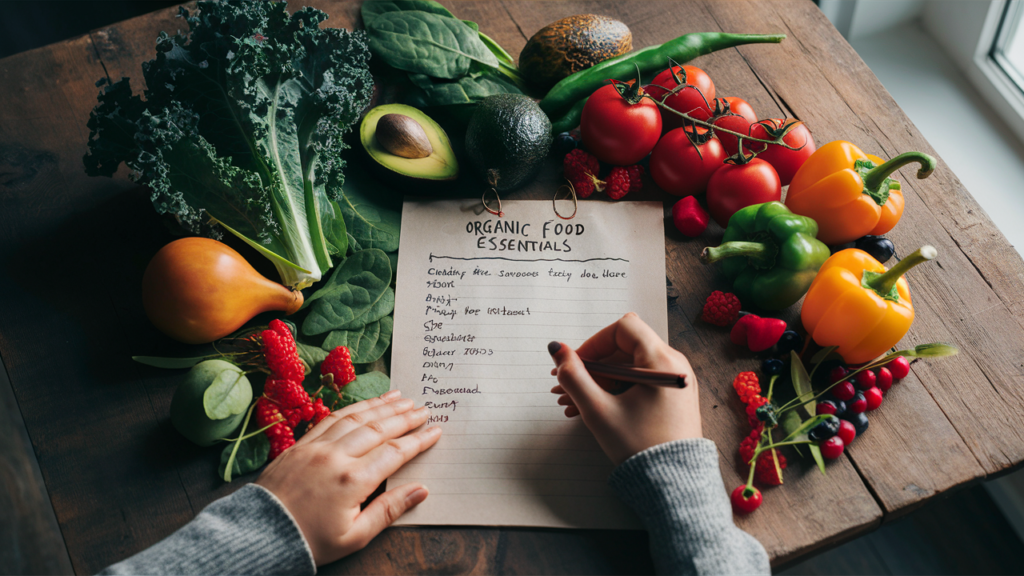
An artfully arranged still life capturing the essence of an organic food list essentials. In the foreground, a wooden crate overflows with vibrant produce – plump tomatoes, crisp greens, and earthy root vegetables. Mid-frame, a woven basket holds an assortment of seasonal fruits, their colors and textures a symphony of natural beauty. In the background, jars and bottles of organic pantry staples – honey, olive oil, whole grains – stand as pillars of a healthy, sustainable lifestyle. Soft, natural lighting casts a warm glow, evoking a sense of rustic abundance and thoughtful nourishment. The composition is balanced, the mood serene, inviting the viewer to imagine the flavorful dishes and nourishing meals these wholesome ingredients will inspire.
Whole Foods Shopping List
Creating a whole foods shopping list helps you eat clean. It focuses on fresh and unprocessed foods for health. Shopping for these items fills your pantry with the good stuff.
- Fruits: Choose a variety of seasonal fruits such as apples, bananas, berries, and oranges for snacking.
- Vegetables: Fill your cart with leafy greens, bell peppers, carrots, and sweet potatoes to add nutrition to your meals.
- Whole Grains: Opt for quinoa, brown rice, whole wheat pasta, and oats as your go-to carbohydrate sources.
- Proteins: Include lean meats like chicken and turkey, fish like salmon, and plant-based options such as beans and lentils.
- Dairy Alternatives: For those avoiding dairy, almond milk, coconut yogurt, and cashew cheese are excellent clean eating options.
- Nuts and Seeds: Stock up on almonds, walnuts, chia seeds, and flaxseeds for healthy fats and snacks.
- Healthy Fats: Make use of olive oil, avocado, and coconut oil to enhance flavor and nutrition in your dishes.
By following this list, you’re choosing to eat healthy. These foods make your meals more exciting. They also make shopping easier.
| Category | Examples | Health Benefits |
|---|---|---|
| Fruits | Apples, Berries, Bananas | High in vitamins and antioxidants |
| Vegetables | Spinach, Carrots, Bell Peppers | Rich in fiber and essential nutrients |
| Whole Grains | Quinoa, Brown Rice, Oats | Supports digestive health |
| Proteins | Chicken, Lentils, Salmon | Builds and repairs tissues |
| Nuts and Seeds | Almonds, Chia Seeds, Walnuts | Packed with healthy fats and protein |
Plan your grocery trip with this list to make things easy. It helps ensure you have everything for healthy meals. This supports a clean eating lifestyle.
How to Meal Plan for Clean Eating
Making a good clean eating meal plan needs smart planning. It helps make better food habits. You also want to keep your meals fun and tasty. Tips for meal planning are key to making things easier and sticking to healthy goals.
Incorporating Variety in Your Meals
To keep enjoying your meals, add different ingredients. Mixing up your food prevents getting bored and gives you more nutrients. Try using fruits and vegetables of many colors, different proteins like lean meats and beans, and various whole grains. This way, meals stay interesting and give you important vitamins and minerals.
Batch Cooking Tips
Batch cooking is great for clean eating. Cook big meals during the weekend or when you’re free. It saves time on busy days and ensures you always have good food ready. Keep meals in single servings for easy grabbing, so you avoid choosing unhealthy options.
Reading Labels: What to Watch For
Understanding food labels is key when you love clean eating. It helps you know what you’re eating. Look at ingredient lists and sugars that aren’t obvious. This lets you pick the healthiest options for your goals.
Understanding Ingredient Lists
Ingredient lists show what’s in your food. Sometimes, the terms are confusing or the names are long. Focus on whole ingredients and avoid overly processed ones. Short ingredient lists are usually better. Look for words like natural, organic, or whole. Knowing common additives helps you shop smarter and keep a clean eating lifestyle.
Identifying Hidden Sugars
Finding hidden sugars on labels can be tough. They have many names like high fructose corn syrup, sucrose, or agave nectar. When you know these names, you can dodge unhealthy options. Also, watch the sugar content in nutrition facts. Lowering added sugars is a big part of eating clean and reaching your health goals.
Clean Eating Recipes to Try
Trying clean eating can be fun and good for you. You’ll find simple breakfast ideas, meals for lunch and dinner, and snacks that are tasty. They keep your meals healthy. All recipes use fresh and whole ingredients. This makes it easy to eat well.
Easy Breakfast Ideas
Start your morning with these healthy and energizing breakfasts. Enjoy smoothies full of fruits and veggies. Or try overnight oats with lots of toppings. These recipes help you plan healthy meals.
- Berry Banana Smoothie: Mix your favorite berries, a banana, Greek yogurt, and spinach for an energy boost.
- Overnight Oats: Mix rolled oats, almond milk, chia seeds, and your favorite fruits for an easy breakfast.
- Veggie Omelette: Mix eggs, diced tomatoes, bell peppers, and spinach for a tasty start to the day.
Lunch and Dinner Options
For lunch or dinner, these meals will keep you full and focused. Each meal is a mix of tasty flavors and nutrition. They help you reach your daily healthy eating goals.
- Quinoa Salad: Mix quinoa with cucumbers, cherry tomatoes, and lemon vinaigrette for a tasty dish.
- Stir-Fried Chicken and Veggies: Cook chicken breast with broccoli, carrots, and bell peppers in a light soy sauce.
- Stuffed Bell Peppers: Fill bell peppers with ground turkey, brown rice, and spices. Bake until tender.
Snacks that Fit Your Goals
Snacks can still be part of clean eating. Choose these healthy options to keep up your energy and satisfy cravings all day.
| Snack Idea | Benefits |
|---|---|
| Hummus and Veggies | This combo is full of protein and fiber to keep you satisfied. |
| Almonds | A great source of healthy fats and antioxidants. |
| Greek Yogurt with Honey | It’s rich in protein and probiotics for digestive health. |
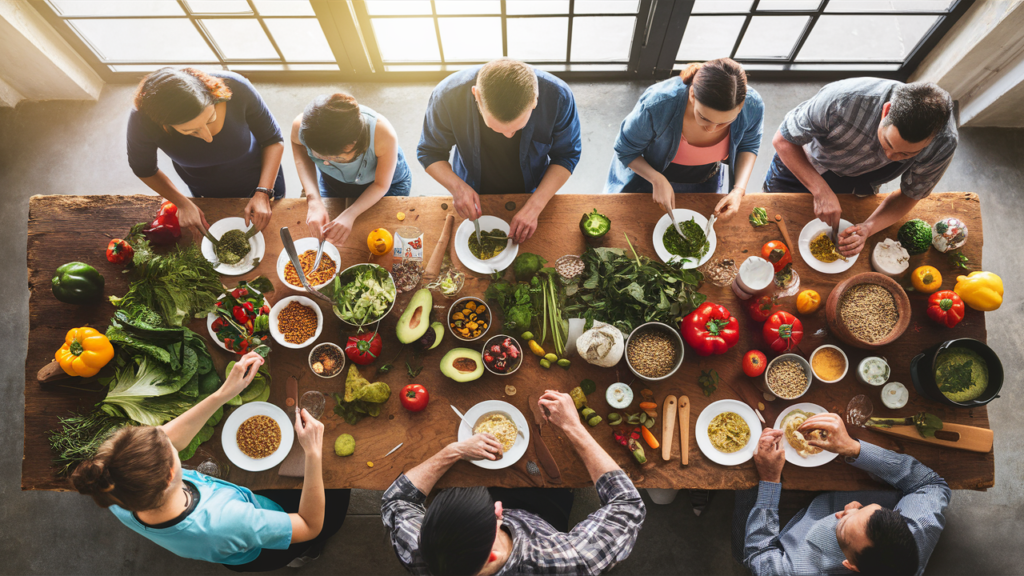
Detailed clean eating recipe book on a rustic wooden table, sunlit from the side, natural light creating soft shadows. Diverse assortment of fresh produce, whole grains, lean proteins, and healthy fats artfully arranged. Crisp food photography style, emphasizing vibrant colors and textures. Recipes presented in an appetizing manner, inviting the viewer to try these nourishing dishes. Minimal clutter, clean and uncluttered composition. Warm, welcoming atmosphere that inspires healthy, mindful eating.
Staying on Track with Clean Eating
Keeping a clean eating lifestyle needs dedication and smart planning. Start with realistic goals that fit your life. Break big goals into smaller ones. It’s easier to stay on track this way. Keeping a journal or using an app helps too. It lets you track your food and how you feel about it.
Talking to people who eat clean can help a lot. Join clean eating groups or forums online. You can share recipes, tips, and stories. This support helps you stick with clean eating, even when it’s hard. Learning from others is very helpful and keeps you going.
Trying new recipes and foods keeps eating interesting. It stops you from getting bored with your meals. It also helps you stick to clean eating. Celebrate all your wins, big or small. It’s all part of the journey.
Common Clean Eating Mistakes to Avoid
Starting a clean eating journey is rewarding. It’s important to know the mistakes to avoid. Some beginners think their meals must be fancy and take a lot of time. But simple, healthy options are often the best. Figuring out what’s unhealthy can be confusing and stressful.
Seeing some foods as “bad” is another mistake. This view can make your relationship with eating tougher. Try to eat different foods but keep things balanced. This way, you can still have treats sometimes. This makes eating well easier to keep up.
Clean eating trends can be too much sometimes. Following strict rules without thinking about what you need can be a misstep. Make your eating plan fit your life and what you like. Stay informed but remember this journey is yours.
Worrying too much about every detail can add stress. Aim to get better, not to be perfect. Knowing and avoiding these mistakes makes clean eating easier and more fun. Embrace your clean eating journey with openness to change and grow.
Adapting Your Grocery List for Dietary Needs
Making a grocery list for clean eating seems hard, but it’s important if you or someone at home needs special food. You can make shopping easier by knowing what foods to pick for health reasons or likes. A good grocery list helps everyone eat well without hurting their health.
Allergy-Friendly Options
It’s key to choose foods that won’t cause allergies when you shop. Watch out for nuts, dairy, soy, and gluten. Here’s how to make a grocery list that’s safe for everyone:
- Choose almond milk or oat milk to replace dairy.
- Opt for quinoa or brown rice instead of products containing gluten.
- Include a variety of fresh fruits and vegetables, ensuring they are free from cross-contamination.
Pick different ingredients to make meals that everyone can eat. They will be yummy and make everyone happy.
Accommodating Different Diets
Changing your grocery list to fit different diets makes cooking more flexible. Add these items to your list for more variety:
- For vegetarians, include legumes, such as lentils and chickpeas, as excellent protein sources.
- For vegans, prioritize plant-based proteins and dairy alternatives, opting for tofu or tempeh.
- Make gluten-free selections by choosing certified gluten-free grains and sneaking in gluten-free snacks.
These changes help meet special food needs and make meals better. Everyone can have tasty and healthy meals, making eating together fun.
Clean Eating Shopping Guide: Tips and Tricks
Start by making a budget for good quality foods. This keeps you from buying things you don’t need. Plan your meals so you know exactly what to buy.
Try shopping at local farmers’ markets for fresh and organic foods. It’s good for you and helps local farmers. In grocery stores, start shopping around the edges first. You’ll find fresh foods like fruits, veggies, meats, and dairy there.
Be sure to read labels when picking food. Choose items with ingredients you know. Avoid foods with many additives. Shopping when it’s not busy gives you time to pick the best items without rushing.
Keep track of what you buy with carts or baskets. This helps you stay on track with your clean eating plan.
Conclusion
Clean eating is more than just a diet. It’s a choice to live healthier. By choosing whole foods and making balanced meals, you set up for a healthier life.
Your journey with clean eating is special, full of chances for good change. Adding these habits to your day can make lasting health benefits. Even small steps matter, so try out what works best for you.
Living a clean eating life means growing personally and sticking with it. With effort and the right tools, you can change the way you eat. Start now and see how your life becomes brighter and healthier.
FAQ
What is clean eating?
Clean eating means choosing whole foods over processed ones. It avoids refined ingredients, sugar, and fake stuff. You eat lots of fresh fruits, veggies, whole grains, lean proteins, and healthy fats.
How do I create a clean eating grocery list?
Start your list with fresh fruits, vegetables, whole grains, and lean meats. Say no to processed items and choose organic when you can. Putting your list into categories makes shopping easier.
Why is it important to eat organic foods?
Eating organic reduces your contact with bad chemicals. Organic items have more nutrients. They support farming that’s good for the planet and are usually fresher.
Can clean eating help with weight management?
Yes, it can. Eating whole foods means fewer calories and more nutrients. This healthy way of eating can lead to lasting weight loss.
What are some easy clean eating recipes for beginners?
Try overnight oats for breakfast, quinoa salad for lunch, and grilled chicken with veggies for dinner. Snacks can be fresh fruit, nuts, or yogurt. These fit well in a clean eating diet.
How can I read food labels for clean eating?
Look at the ingredients list for whole foods. Avoid added sugars, fake preservatives, and overly processed items. Learning about hidden sugars helps you choose better.
What are some common mistakes to avoid when starting clean eating?
Avoid making meals too complex, depending too much on “clean” store buys, and not planning meals. Simple meals help you stay on track with clean eating.
Can I adapt my grocery list for dietary restrictions?
Yes, you can pick allergy-safe or special diet options. This allows you to enjoy clean eating while taking care of your dietary needs.
